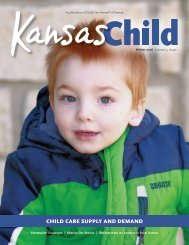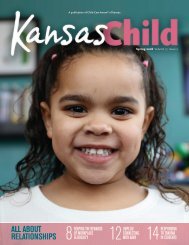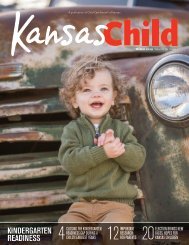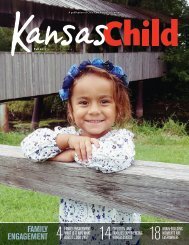2021Winter KansasChild_Final (4)
Create successful ePaper yourself
Turn your PDF publications into a flip-book with our unique Google optimized e-Paper software.
Am I Making Myself Clear?
CHELSEA SCHULTE
Program Coordinator,
KCCTO-KITS Infant
Toddler Specialist Network
Chelsea Schulte is the Program
Coordinator for the KCCTO-KITS
Infant Toddler Specialist Network. She
received her B.S. and M.S. in Early Childhood
Education from Kansas State University. She
has experience with training and technical
assistance, as well as direct service for children
in both licensed child care and district settings.
BY CHELSEA SCHULTE
How frequently do you share information through written language? Think about parent
handbooks, policies-and-procedure manuals, websites, social media pages, contracts, etc.
This list goes on and on.
How frequently do you have to clarify information you shared through written language?
Someone calls with questions about something they read on your website or social
media page. A parent insists the sick policy in your handbook doesn’t cover the symptoms
their child has right now, so they should be able to attend.
You might ask yourself, “How do I make myself more clear?” I have just the answer
for you.
Follow the Federal Plain Language Guidelines.
These guidelines were originally developed to make government regulations easier to
understand; however, they can be applied to any written language. The guidelines address
a range of issues with written language, including big-picture guidelines such as identifying
your audience, as well as specific guidelines, such as using short, simple words.
When you use the guidelines in your written language, your reader benefits from the
clarity. Where to begin, you ask?
I recommend reading the guidelines completely. Don’t be alarmed by the length of the
118-page document. It is a quick and easy read. I have read it multiple times and still
reference it regularly, even while writing this article!
Below I have listed some of the guidelines I use regularly when writing or revising
written language:
• Address one person, not a group
When writing your document, consider who your audience is. If you are writing a
parent handbook for your child care program, the audience is the parent. Write as if
you are talking directly to a parent, not a group of parents.
• Use lots of useful headings
Headings break up chunks of text and allow the reader to quickly find the
information they are looking for. Headings can be in the form of questions,
statements, or topics, but should be consistent throughout the document.
• Use active voice
When you use an active voice, you let the reader know who is responsible
for what. Rather than saying “Nap blankets must be washed every 5 uses,”
say, “I will send home nap blankets on Fridays for you to wash over the
weekend.”
• Use “must” to indicate requirements
As you write, consider whether you are describing a requirement
or a recommendation. If you require parents to remove their shoes
when they enter your program, say, “You must remove your shoes in
the entryway.” If you want parents to remove their shoes, but it isn’t
required, use the word “should” instead.
• Write short sentences
Limit each sentence to one idea. If your sentence is getting
long, break it into multiple sentences.
For more information and to read the guidelines in their entirety,
visit www.plainlanguage.gov/guidelines. The next time
you find yourself clarifying something you’ve shared through
written language, review your document alongside the guidelines
to see where you can improve your writing.
Have I made myself clear?
• Reference: Plain Language Action and Information Network. (2011).
Federal plain language guidelines. www.plainlanguage.gov/guidelines
10
A Publication of Child Care Aware ® of Kansas
















